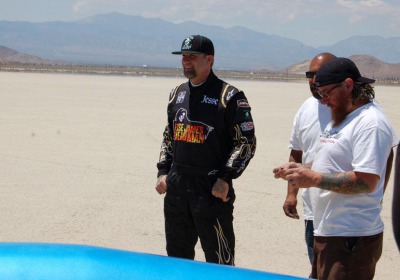Jesse James brings hydrogen land-speed record back to America
Wed, 17 Jun 2009
Six years after he got the idea and bought the streamliner, Jesse James has set the world record for hydrogen-powered speed.
Late afternoon on June 16, James flew across the windswept dust of El Mirage dry lake bed in the California desert and tripped the lights at 199.712 mph. That was 14 mph faster than the previous record of 185 mph, set in Germany by BMW in its hydrogen-powered H2H.
"This, I honestly believe, is world-changing," James said of the emissions-free race car. "We can't rely on gasoline forever. I'm paying it forward."
The whole deal was for the season-ending episode of James's TV show, Jesse James is a Dead Man. The episode is set to air at 10 p.m. Eastern on Aug. 9 on the Spike TV network.
The land-speed car also shows that alternative-fuel cars can have a popular appeal, James said.
"We don't have to be dorks to make things environmentally friendly."
But it's not that simple. You can't just strap a bigger blower onto a bigger engine and get speed. The engine itself took three years of development to make power on hydrogen. Converting the 572-cubic-inch Chevrolet crate motor to hydrogen was first attempted by Quantum Technologies, which then handed the project over to Detroit engine deity Kurt Urban. The problem was heat.
"As you make power, you make heat," Urban said.
All engines do that, of course, but with hydrogen, you have significant obstacles to overcome. Urban invented all kinds of ways to deal with the heat.
The biggest and potentially most-lethal problem was that the hydrogen would ignite back into the intake runners. So Urban used longer intake runners that also had a low profile to fit under the hood. The runners he chose are the same ones used on Can-Am race cars back in the day. Then he introduced a means to inject water into the runners as needed to prevent detonation of the fuel there. Water shoots into the twin turbochargers to cool them, too.
A large tank packed with ice and water sits inside the car's nose. When the engine temperature rises above 170 degrees, the ice water flows through the block to cool it down. With runs that last only a minute or two, you have options you wouldn't have on a regular car.
Twenty-four injectors spray fuel into the eight cylinders. A normal V8 would have eight. The car carries three, 5,000-psi tanks of gaseous hydrogen.
"The engineers said it couldn't go over 500 hp," said Urban. "This one makes 740. Sometimes engineers are too smart."
James made a trial run on the abandoned runways of El Toro before coming to El Mirage.
"Just to make sure the transmission and everything worked," said Urban.
It did, but, as any land-speed racer or any racer with a new car will tell you, nothing ever goes right the first time.
James aborted his first run at El Mirage when dust immediately filled the cockpit, blinding him. The crew, led by revered land-speed legend Mike Cook, quickly sealed up the cockpit and any other potential entry point for dust. Instead of anything high-tech, they used cardboard and duct tape. To block a large opening above the parachute tubes, they stuffed in a pillow.
A test run showed that there was still too much dust. So the crew used more cardboard and more duct tape.
Another test run showed that the dust was tolerable, but the engine wasn't making the power. So the Cook family, Cook friends, SCTA members and the heavily tattooed West Coast Chopper team opened up the air intake using tin snips, crescent wrenches, hammers, wooden blocks and, finally, a baseball bat.
As daylight ran out, James flew through the timing lights of the SCTA course at 199 mph.
"Not bad for a bunch of guys with no college degrees, huh?" said James of his West Coast Choppers crew.
And even when two members of the team sheepishly admitted that they indeed had college degrees, it was still quite an accomplishment.
By Mark Vaughn

